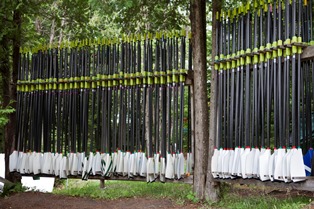10 Tips for Keeping Oars in Tip-Top Shape
As we attend races throughout the year, we’re often surprised at the amazingly good condition of older equipment that we see from caring coaches and rowers. Unfortunately, we’re equally astonished at how quickly newer equipment can be damaged by carelessness.

With Autumn here, we've put together
10 tips to help make your oars and sculls last:
- Create a culture of inspecting and cleaning equipment. It is important to catch damage as soon as possible; it can be dangerous to row with a damaged oar. Inspect for blade dents, shaft cracks, or water in the shaft. Feel for soft spots on the shaft; this could indicate invisible cracks. Clean handles and grips. Don’t neglect oarlocks either--keep them clean and grit-free.
- Store oars and sculls in racks with the handles up, when possible. Avoid scratching blades in gravel, on concrete, and against docks and other hard surfaces. Blade damage most often occurs at the edge of the blade due to scuffing or hitting against something.
- Do not store your oars long-term in continuous sunlight. Ultraviolet light will eventually degrade the surface and shorten the life of the oar.
- Keep an eye out for signs of wear on the sleeves. A worn sleeve will affect feathering, your roll-up, and pitch. Sleeves should be replaced as needed, but a clean and well-cared for sleeve will last a long time.
- Transporting oars on unprotected metal roof racks can cause serious damage. Tie on oars with adequate padding, or use the Concept2 scull case for protection.
- On docks, lay oars and sculls with tips up to avoid wearing. Keep oars out of the way of being stepped on.
- When carrying oars to and from the dock, do not bundle them. This often leads to blades knocking against one another in transit, and oars are often dropped carelessly.
- Do not push away from the dock with your oars. Practice pushing away as a crew or walking down the dock.
- Rowing in salt water? Rinse equipment after every use. Pay special attention to sleeves, collars and oarlocks.
- Encourage teammates to report any potential damage to equipment. Even if equipment does not look broken, simple acts such as catching a crab, hitting a bridge abutment, or finding a big log in the river may lead to damage. Many rowers are too embarrassed or scared to report collisions. Reward athletes who speak up.
